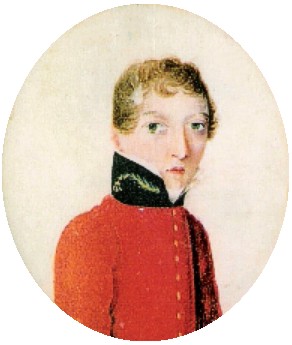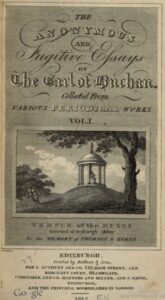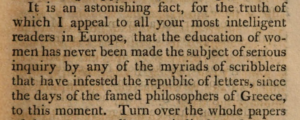James Barry – first woman graduate, 1812

James Barry (c.1789-1865) studied Medicine in Edinburgh 1809-12, his final examinations being deferred as he seemed too young. The Earl of Buchan wrote to the University authorities pointing out that the regulations made no mention of a minimum age, and Barry was allowed to sit. He defended his thesis and knowledge of medical cases to the professors in Latin, as was then required. He went on to become a successful military surgeon, eventually a General. In his postings around the world, and particularly South Africa, he became known for his skill and high standards, but also for his fiery and difficult personality. Florence Nightingale wrote a strongly worded account of her interaction with him.
When he died in 1865, it was discovered that he was born a woman. This was received with sensational public interest, but with more fascination than criticism.
The story
Barry was born Margaret Bulkley. She came from a middle class family in Cork that had fallen on hard times. She came to London with her mother to seek help from her mother’s brother, a successful historical artist called James Barry (1741-1806). They didn’t get much help, but shortly afterwards uncle James died, and they inherited some money. University education for women was not entertained in early 19th century Britain. Margaret’s subterfuge and medical education were made possible through the active support of several people, starting with her mother. Francisco de Miranda, a prominent and adventurous Venezuelan exile in London, gave access to his library. A doctor friend of Miranda’s, Dr Edward Fryer, tutored Margaret in subjects she hadn’t learned. A discrete lawyer was involved, and David Steuart Erskine, Earl of Buchan, became an important local advocate and supporter while she was in Edinburgh.

 Margaret suddenly became James Barry during the sea voyage from London to Leith, and there seems to be no subsequent trace of Margaret. In Edinburgh there was just James Barry living with his mother, whom he described as his aunt. It has been speculated that the long term plan may have been for Margaret/James to follow Miranda to Venezuela, where it might have been possible practise medicine as a woman. However Miranda was imprisoned in Spain shortly before Barry’s graduation, and he remained in captivity until his death 4 years later.
Margaret suddenly became James Barry during the sea voyage from London to Leith, and there seems to be no subsequent trace of Margaret. In Edinburgh there was just James Barry living with his mother, whom he described as his aunt. It has been speculated that the long term plan may have been for Margaret/James to follow Miranda to Venezuela, where it might have been possible practise medicine as a woman. However Miranda was imprisoned in Spain shortly before Barry’s graduation, and he remained in captivity until his death 4 years later.
Erskine had published previous anonymous essays for a magazine ‘The Bee’, including some which argued strongly for women’s education. Just after Barry graduated, Erskine republished these in a book in his own name, The Anonymous and Fugitive Essays of David Steuart Erskine, The Earl of Buchan. Erskine gave significant support and encouragement during Barry’s time in Edinburgh. He had previously had close connections with uncle James Barry the artist, in 1805 leading a subscription to support him when he lost his income after being expelled from the Royal Academy of Arts (an almost unique achievement, see references below).
The 3 years of medical studies cost £202 in tuition and examination fees. Barry seems to have been a very conscientious and academically able student, and subsequently also clinically skilled, sympathetic to patients regardless of their background, and driven to improve services. He is reported to have performed the first successful Caesarean section in Africa, in that mother and baby both survived. The baby was named James Barry Munnik.
However he seems to have been thought unusual, and fell out with many people, including Florence Nightingale (“I should say that he was the most hardened creature I ever met”). He was strident, fought duels, and generally upset people, either because that was his personality, or maybe at times compensating for his slight figure and boyish appearance. Some contemporary accounts can be interpreted as hinting that people suspected that he might be a woman, but didn’t enquire further.
Barry lived an apparently rather solitary personal life, with an African servant John, and a series of dogs all called Psyche.
Barry had a distinguished, if at times tempestuous, career in Army Medicine, retiring as a General. That he had a career at all was a remarkable feat at a time when women were not accepted as either university students or as doctors.
Women in Medicine in the 1800s
The first woman to qualify in medicine in the UK without subterfuge was Elizabeth Garrett (Anderson) in 1865, the year of Barry’s death from dysentery. Garrett struggled to gain her qualification eventually from the Society of Apothecaries in London, who promptly changed their regulations so that no other women could follow. The British Medical Association did the same. In 1869 the University of Edinburgh admitted seven women to study Medicine, the first female university undergraduates (of any subject) in the country. Their cause was initially promoted by the professor of Divinity, who won support from the University Senate. But their progression was stalled by reactionary responses from some senior staff, including the Dean of Medicine and a noisy group of students, and they were not allowed to graduate. The Edinburgh Seven story is told on other pages.
Modern perspectives and research
It is an astonishing tale, which has been told and retold many times. The evidence of Barry’s origin was assembled by Michael du Preez (see references below).
It is tempting in the 21st century to suggest that gender transition was Bulkley’s aim from the outset. But it does not seem possible to know at this distance. There is little evidence for earlier gender uncertainty, and it is certainly the case that as Margaret Bulkley it would not have been possible to become a doctor, and harder to secure an independent income. Fortunately we can respect the achievements without knowing. Mariel Tishma (ref below) lists hypotheses.
Further info
Dr James Barry, A Woman Ahead of Her Time, by Michael du Preez & Jeremy Dronfield, 2016. Based on impressive original research, grippingly told in Michael du Preez & Jeremy Dronfield’s novelised account, 2016. du Preez hypothesizes about a possible sexual assault from a family member in teenage years, and a couple of hints that there may have been a pregnancy at some point. Also speculation about an affair with Lord Charles Somerset, Governor of the Cape, to whom he was physician. This is picked up by Tishma (see below).
Dr James Barry: The early years revealed – du Preez HM, 2008, South African Medical Journal (pdf) – the definitive account, with lots of colourful detail about the origins of the deception and the true identity of Dr Barry, and the radical society that Margaret joined in London.
Dr James Barry: the Edinburgh years – HM du Preez, 2012, Proc RCPE (pdf). A shorter authoritative account.
David Steuart Erskine, The Earl of Buchan. Anonymous and fugitive essays, 1812. You can dip into Erskine’s eccentric essays, previously published anonymously in the magazine ‘The Bee’. Although it is nowhere confirmed that he knew Barry/Bulkley’s secret, his writings about the importance of educating women, and the level of support he gave this unusual student, suggest that he was fully in the picture.
Wikipedia on James Barry is good but not the definitive account. .
The Secret Historian: An informal biography of his time in the Cape and a particularly good article James Barry (Secret History Project); includes link to this contemporary newspaper article.
The life, work and gender of Dr James Barry – Kubba AK, 2001, Proc RCPE (pdf) – believes on vanishingly slim evidence that Barry had an intersex condition.
Mariel Tishma 2020. A surgeon and a gentleman: the life of James Barry. Hektoen International. A carefully researched and very readable account that summarises and references the evidence nicely, and dwells on his career as well as rumour and modern perspectives.
Barry’s 1812 MD thesis A scan of Barry’s MD thesis on Femoral Hernias can be downloaded in its original Latin with English translation. It is dedicated to General Miranda and Earl Buchan. Barry, an Irish woman studying in Scotland, describes herself here as ‘James Barry, an Englishman’.
James Barry, artist – Jim Doyle blog. Describes links to the Earl of Buchan. RA archives hold an 1805 letter from Barry to Erskine.
The featured image dated 1813-16 appears in du Preez’s article of 2008, where he reports that it is still in the possession of the Munnik family.




I am tired of hearing that every woman who had to hide her sex in order to achieve what she wanted to achieve in a man’s world being retrospectively transed. She was a woman. A remarkable and amazing woman. This academically fashionable retrospective transing seems to take the view that any woman who behaved in a gender non-conforming manner was not really a woman at all – but a man, instead. This approach is reminiscent of the inflexible views of gender norms that were prevalent in the 1950s – any woman in history who behaved in a gender non-conforming manner can’t possibly have been a woman, she must have been a trans man. It’s reductive and insulting.
In the absence of a personal account from Margaret/James, or any suggestive comments from observers before the swap, I agree. There are other contemporary accounts of women posing as men to earn a living in ‘mens work’.